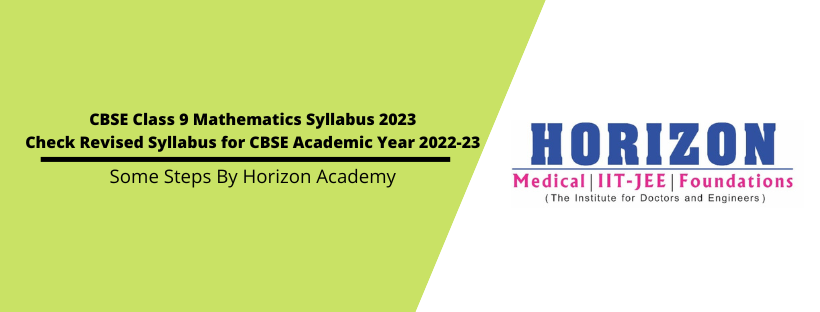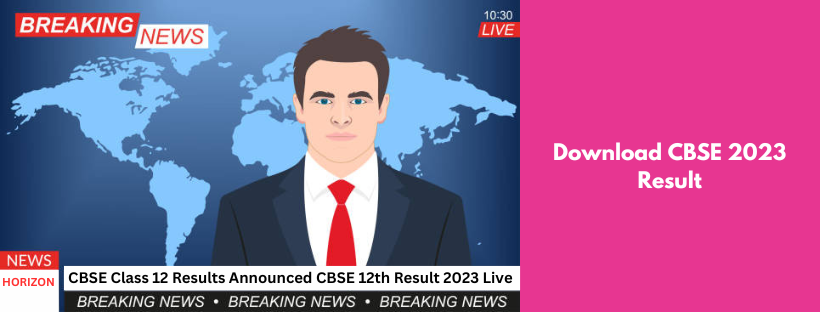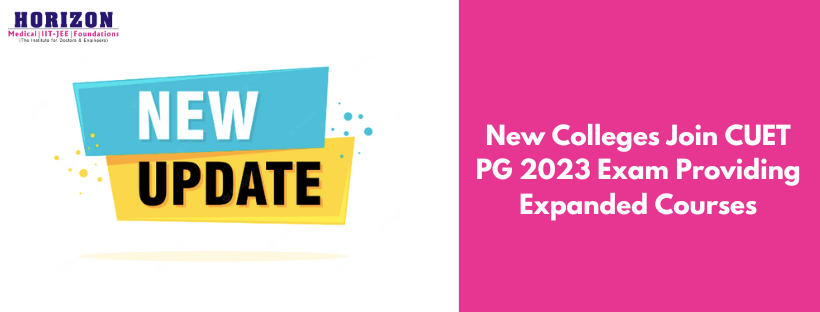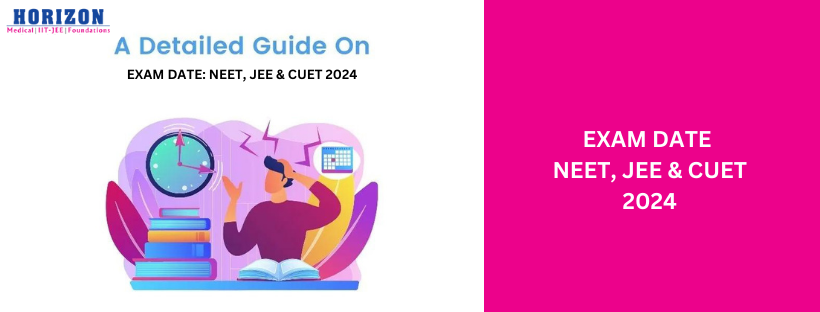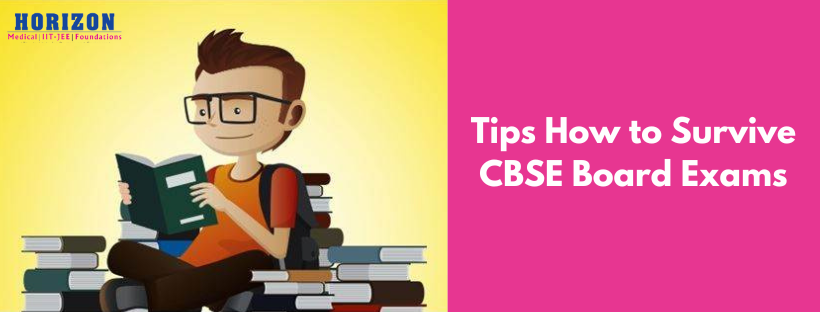CBSE Class 9 Mathematics Syllabus 2023
Check Revised Syllabus for CBSE Academic Year 2022-23
Horizon Academy Best IIT Coaching in East Delhi have covered the detailed CBSE Class 9 Maths Syllabus 2023 on this page. Students must refer to the CBSE Class 9 Maths Syllabus 2023 and start their preparation.
CBSE Class 9 Maths Syllabus 2022-23
Maths is one of the most scoring and interesting subjects and if students make a proper plan and study accurately then they can surely achieve excellent marks. The central board of secondary education has released the revised syllabus for CBSE Class 9 English syllabus to make students aware of the chapter-wise weightage, marks distribution, and a lot more.
| Unit Name | Marks |
| Unit 1: Number System | 10 |
| Unit 2: Algebra | 20 |
| Unit 3: Coordinate Geometry | 04 |
| Unit 4: Geometry | 27 |
| Unit 5: Mensuration | 13 |
| Unit 6: Statistics and Probability | 6 |
| Total | 80 |
Question Paper Design
| S.No | Typology of Questions | Total Marks |
| 1 | Remembering Understanding |
43 |
| 2 | Applying | 19 |
| 3 | Analysing Evaluating Creating |
18 |
| Total | 80 |
| Internal Assessment | 20 Marks |
| Pen Paper Test and Multiple Assessment (5+5) | 10 Marks |
| Portfolio | 05 Marks |
| Lab Practical (Lab activities to be done from the prescribed books) | 05 Marks |
Unit I: Number Systems
Real Numbers
Review of representation of natural numbers, integers, and rational numbers on the number line. Rational numbers as recurring/ terminating decimals. Operations on real numbers.
- Examples of non-recurring/non-terminating decimals. Existence of non-rational numbers (irrational numbers) such as 2–?,3–?2,3and their representation on the number line. Explaining that every real number is represented by a unique point on the number line and conversely, viz. every point on the number line represents a unique real number.
- Definition of nth root of a real number.
- Rationalization (with precise meaning) of real numbers of the type 1a+bx?1a+bxand 1x?+y?1x+y (and their combinations) where x and y are natural numbers and a and b are integers.
- Recall of laws of exponents with integral powers. Rational exponents with positive real bases (to be done by particular cases, allowing the learner to arrive at the general laws.)
Unit II: Algebra
- Polynomials
Definition of a polynomial in one variable, with examples and counter examples. Coefficients of a polynomial, terms of a polynomial, and zero polynomial. Degree of a polynomial. Constant, linear, quadratic, and cubic polynomials. Monomials, binomials, trinomials. Factors and multiples. Zeros of a polynomial. Motivate and State the Remainder Theorem with examples. Statement and proof of the Factor Theorem. Factorization of ax2 + bx + c, a ?? 0 where a, b and c are real numbers, and of cubic polynomials using the Factor Theorem.
- Linear Equations in Two Variables
Recall of linear equations in one variable. Introduction to the equation in two variables. Focus on linear equations of the type ax + by + c = 0. Explain that a linear equation in two variables has infinitely many solutions and justify their being written as ordered pairs of real numbers, plotting them and showing that they lie on a line.
Unit III: Coordinate Geometry
The Cartesian plane, coordinates of a point, names and terms associated with the coordinate plane, and notations.
Unit IV: Geometry
- Introduction to Euclid’s Geometry
History – Geometry in India and Euclid’s geometry. Euclid’s method of formalizing observed phenomenon into rigorous Mathematics with definitions, common/obvious notions, axioms/postulates, and theorems. The five postulates of Euclid. Showing the relationship between axiom and theorem, for example: (Axiom) 1. Given two distinct points, there exists one and only one line through them. (Theorem) 2. (Prove) Two distinct lines cannot have more than one point in common.
- Lines and Angles
- (Motivate) If a ray stands on a line, then the sum of the two adjacent angles so formed is 180oand the converse.
- (Prove) If two lines intersect, vertically opposite angles are equal.
- (Motivate) Lines which are parallel to a given line are parallel.
- Triangles
- (Motivate) Two triangles are congruent if any two sides and the included angle of one triangle is equal to any two sides and the included angle of the other triangle (SAS Congruence).
- (Prove) Two triangles are congruent if any two angles and the included side of one triangle is equal to any two angles and the included side of the other triangle (ASA Congruence).
- (Motivate) Two triangles are congruent if the three sides of one triangle are equal to the three sides of the other triangle (SSS Congruence).
- (Motivate) Two right triangles are congruent if the hypotenuse and a side of one triangle are equal (respectively) to the hypotenuse and a side of the other triangle. (RHS Congruence)
- (Prove) The angles opposite to equal sides of a triangle are equal.
- (Motivate) The sides opposite to equal angles of a triangle are equal.
- Quadrilaterals
- (Prove) The diagonal divides a parallelogram into two congruent triangles.
- (Motivate) In a parallelogram opposite sides are equal, and conversely.
- (Motivate) In a parallelogram opposite angles are equal, and conversely.
- (Motivate) A quadrilateral is a parallelogram if a pair of opposite sides are parallel and equal.
- (Motivate) In a parallelogram, the diagonals bisect each other conversely.
- (Motivate) In a triangle, the line segment joining the midpoints of any two sides is parallel to the third side and in half of it and (motivate) its converse.
- Circles
- (Prove) Equal chords of a circle subtend equal angles at the center and (motivate) its converse.
- (Motivate) The perpendicular from the center of a circle to a chord bisects the chord and conversely, the line drawn through the center of a circle to bisect a chord is perpendicular to the chord.
- (Motivate) Equal chords of a circle (or of congruent circles) are equidistant from the center (or their respective centers) and conversely.
- (Prove) The angle subtended by an arc at the center is double the angle subtended by it at any point on the remaining part of the circle.
- (Motivate) Angles in the same segment of a circle are equal.
- (Motivate) If a line segment joining two points subtends an equal angle at two other points lying on the same side of the line containing the segment, the four points lie on a circle.
- (Motivate) The sum of either of the pair of opposite angles of a cyclic quadrilateral is 180° and its converse.
Unit V: Mensuration
- AREAS
Area of a triangle using Heron’s formula
- SURFACE AREAS AND VOLUMES
Surface areas and volumes of spheres (including hemispheres) and right circular cones.
Unit VI: Statistics & Probability
STATISTICS
Bar graphs, histograms (with varying base lengths), and frequency polygons.
Prescribed Books:
- Mathematics – Textbook for Class IX – NCERT Publication
- Guidelines for Mathematics Laboratory in Schools, class IX – CBSE Publication
- Laboratory Manual – Mathematics, secondary stage – NCERT Publication
- Mathematics exemplar problems for class IX, NCERT publication.
Concussion
Horizon Academy best Jee Coaching in East Delhi always try to make our student’s ways easier so that they can study in the right way we tried our best to provide study material that helps them to study. Horizon Academy best Jee Coaching in East Delhi collects all the information which can help our students to make a study plan.
Frequently Ask Questions
- Will CBSE conduct CBSE Class 9 Exam 2023 annually?
Yes, CBSE has recently announced that from the next session CBSE will conduct annual board exams.
- Where I can get CBSE Class 9 Mathematics Syllabus 2023?
You can get the detailed CBSE Class 9 Mathematics Syllabus 2023 here or on the official CBSE website.
- How many units are there in CBSE Class 9 Mathematics Syllabus 2023?
There are 6 units in CBSE Class 9 Mathematics Syllabus 2023. The CBSE Class 9 Mathematics Syllabus 2023 covers Number systems, Algebra, Coordinate Geometry, Geometry, Mensuration, Statistics, and Probability.
- What is the importance of knowing the CBSE Class 9 Maths Syllabus?
Knowing the syllabus of maths can help the students in the following ways:
- Preparing a study plan for examinations
- Gives a clear idea about the pattern and distribution of marks
- A clear overview of the important topics that should be given special importance
- Keep a track of all the topics that are still pending
- Helps them to be confident during the exams
- Which is the easiest chapter in class 9 maths?
For most students, Number systems are the easiest chapter of all.

